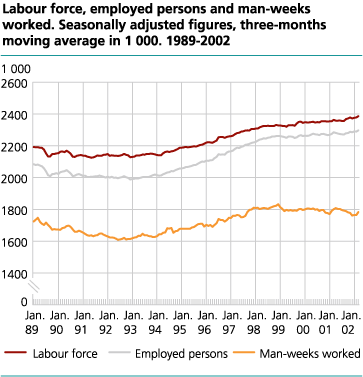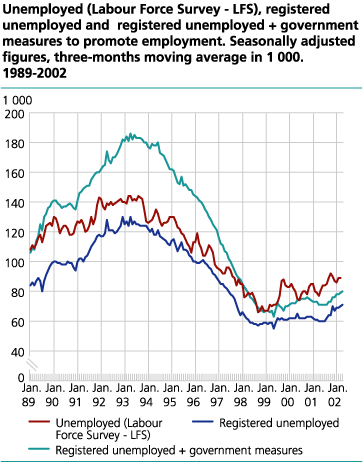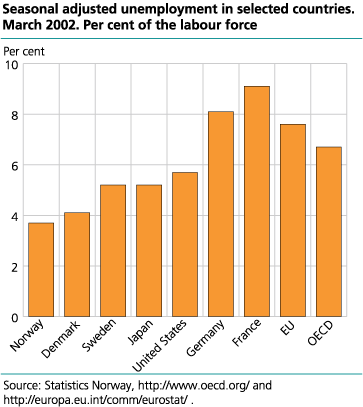Content
Published:
This is an archived release.
Stable labour market
The numbers of unemployed persons were unchanged from the 3-months period November-January to February-April, while numbers of employed persons increased slightly. The numbers are adjusted for seasonal variations.
The total numbers of employed persons increased by 13 000 from November - January to February - April this year. The increase is within the error margins for the figures of change in the LFS caused by sample uncertainty.
A total of 2 276 000 persons were employed and 97 000 persons were unemployed in the 1s t quarter of 2002 according to figures from the LFS, not seasonally adjusted.
Unemployment in EU and OECD: 7.6 and 6.7 per cent
The seasonally adjusted unemployment rate in Norway was unchanged at 3.7 per cent from December last year to March this year, while the average in the EU was unchanged at 7.6 per cent. The rate in the OECD-countries as a whole decreased from 6.9 to 6.7 per cent. In March 2002 the unemployment rate was 5.7 in USA, 0.1 percentage point lower than in December last year. For Sweden, the unemployment rate was unchanged at 5.2 per cent, while in Denmark, the unemployment rate fell to 4.2 per cent. This is according to figures from the Eurostat and the OECD .
Man-weeks worked
The number of man-weeks worked increased by 23 000 from the 3-months period November - January to February - April this year. Due to different pre-corrections for holidays that fall in random months, the man-weeks figures are especially uncertain.
Previous to the seasonal adjustment, we make adjustments for holidays that fall in random months every year. Due to the fact that Easter Monday was included in the April interviews this year, we adjust the figure of man-weeks worked up by 111 000 before seasonal adjustment. The adjustments are made so that the relative change in average weekly working hours from November to April this year is like last year's. For the same reason man-weeks worked April last year was pre-adjusted up by 144 000.
The purpose of adjusting for seasonal variations is to describe the development during the last year and to give figures for change between the last two 3-month periods, cleared for normal seasonal variations. In order to reduce uncertainty, the presented series are three months moving averages of the seasonally adjusted figures. For instance the figure from March is the average of the estimates from February, March and April.
Tables:
The statistics is published with Labour force survey.
Contact
-
Arbeidsmarked og lønn
E-mail: arbeidsmarked@ssb.no
-
Erik Herstad Horgen
E-mail: erik.horgen@ssb.no
tel.: (+47) 93 08 68 62



